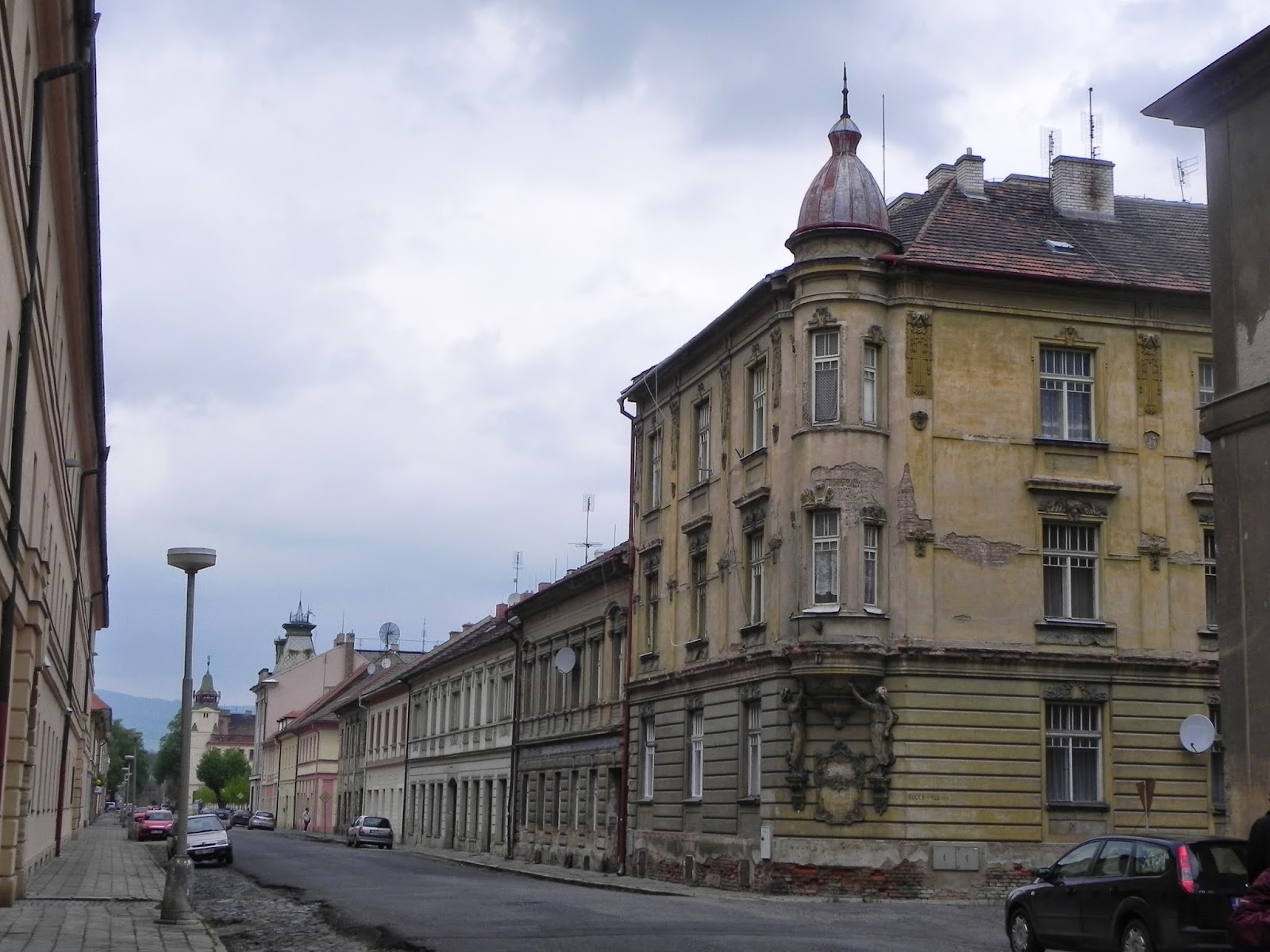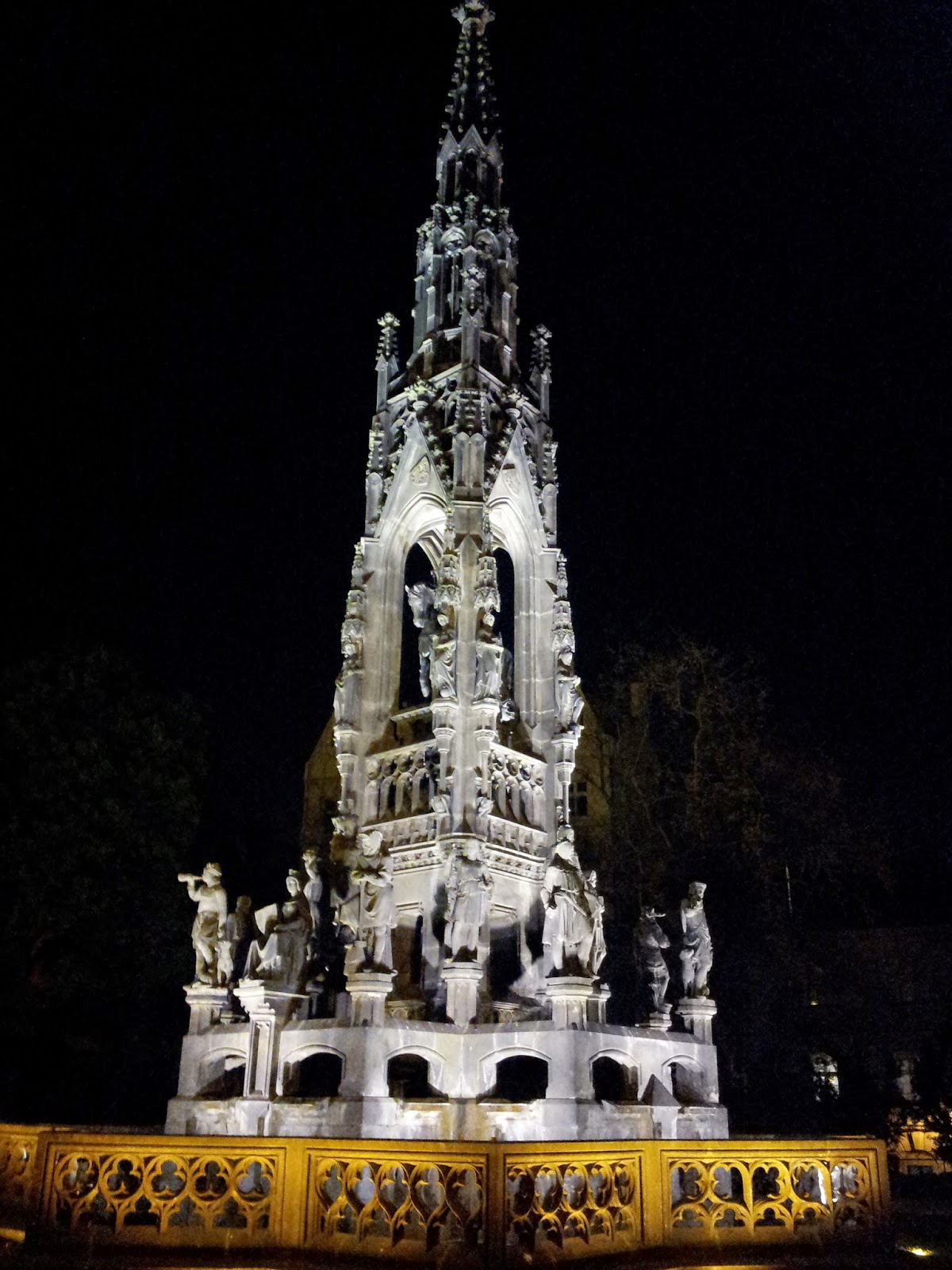Let me emphasise that – “peace in OUR time”. Specifically, for
certain countries in Western Europe and beyond the oceans. The appeasement strategy in the time leading
up to World War Two paved the way for atrocities in Czechoslovakia. Tijo Knoll, another Sandeman’s guide, taught
us of one of these in particular today: Terezin. (Tijo is not a local
Czech. However, whatever he may lack in
personal perspective for this tour is compensated by his professional area of
expertise: Psychology. A very
interesting person to guide us through a former concentration camp!)
Terezin was originally a fortress town built in the late
1700s as a defensive structure for the Austrian Empire. Though built to be impenetrable according to
the military standards of the day, Terezin was obsolete shortly after it was
built – the result of the dramatic changes in warfare. Though no longer useful as a defensive fort,
Terezin was nevertheless used as a garrison for approximately three thousand
soldiers, as well as a prison for the likes of Gavrilo Princip (who
assassinated the Archduke Franz Ferdinand, providing the most proximate cause
for the start of World War One). The
town of Terezin – inside the fort – included an additional two thousand civilians.
When the Nazis occupied Czechoslovakia, they turned Terezin into a
concentration camp for Jews from Czechoslovakia, Denmark, the Netherlands…from wherever
it was convenient.
Today, Terezin once again houses some two thousand
civilians, but the garrison is gone.
With no military infrastructure, the town lacks investment, economic opportunities,
and purpose. The decay is evident where
resources are simply insufficient to maintain the crumbling buildings. However, for the people who live there, it is
still home.
Apparently natural, these giant rats that congregate around the streams in the old fort moat. These things are the size of small dogs!
Our trip to Terezin, although under incomparable circumstances,
followed the path of the Jews who were forced there. We disembarked from the main train station
and walked the mile or so to the fort. In
time, the Nazis extended the railway right into the fort itself. This was not an act of generosity toward the
Jews; the Nazis simply did not want the locals to see what was going on. (With respect to the circumstances…the very
first Jews transported to Terezin were older people who had been “sold” a
retirement residence in the picturesque setting of Terezin. They sold their properties, packed their
belongings, and arrived expecting a quiet and peaceful life. Their shock began when they were told they
had to walk, carrying all of their belongings, from the station to the fort.) Though
I knew what I was getting into, I couldn’t help but notice the serene
surroundings; naturally beautiful landscapes and birds singing. It is strangely juxtaposed against what took
place there less than a lifetime ago.
I don't normally get too caught up with my own photography, but I love this photo. This is where the tracks end just inside the gates to Terezin. This Jewish man was on our tour; relatives of his had faced the concentration camps in World War Two. The symbolism really gets me.
According to Nazi propaganda, Terezin was a town that was “gifted
to the Jews”. A place they could call
their own. This gross distortion of the truth
was validated by the Red Cross when they examined the camp to ensure it was
fit. Somehow, the rest of the world was
satisfied that forcibly moving people from their homes and relocating them to a
confined camp was acceptable, provided that this prison included a used clothing
store (where the prisoners could purchase their own clothes that had previously
been confiscated) and had its own Jewish money. (The bank notes had the face of
Moses. The original graphics were
changed by the Nazi authorities to make the faces more “Jewish”; Moses’ nose
was made longer and more crooked.) Ingrained anti-Semitism may have been the
immediate cause for this acceptance, though we didn’t do much better in the face
of Rwanda. Perhaps most cruel for the
purposes of propaganda was the fact that Jewish prisoners were filmed tending
vegetable gardens for the rest of the world to see. Though the gardeners smiled and laughed as
they weeded and hoed, they were never to enjoy the fruits of this labour. Those vegetable gardens were to feed the Nazi
SS.
The propaganda was that Terezin was a Jewish idyll. The reality is that this fort, made to house
seven thousand people, reached a peak population of 58 000 prisoners. Death was a reality every day, not only due
to horrific abuse at the hands of the guards, but also to over-crowding and a
lack of the basic necessities of life.
As per Jewish custom, those who died in the early days at
Terezin were buried in coffins made of wood.
In time, as the death rate increased, mass graves were
implemented and coffins were deemed superfluous; burial sites were identified
only by the approximate placement within a grid outline.
Finally, as even this system was overwhelmed, a crematorium
was built. The crematorium had a
capacity for up to 180 bodies per day.
In the end, over 20 000 bodies are buried in the graves
around Terezin.
Conservative Jews are opposed to cremation, as they believe
their bodies are to be buried in the ground – untouched – after death. Consequently, it was a new horror not only
for these Jews to face cremation at Terezin, but also for the Jewish inmates to
have to build and operate the crematorium, themselves. Further, upon direction
from the Nazi SS, the Jewish workers of the crematorium had to sift through the
ashes of the bodies to ensure that gold fillings and such were retrieved before
the ashes were disposed.
I should clarify something when I keep referring to the Jews
at Terezin. The peculiarities of the
Nazi definition of Jewish meant that there was a substantial population of
non-Jewish (according to self-identification) prisoners in Terezin. The Nazis deemed that anyone with three out
of four grandparents identified as Jewish was also Jewish, irrespective of
practice, belief, or self-identification.
Think about that. People who were
several generations away from practicing Judaism could be sent to Terezin
simply because of the cascading effect of this “three out of four” principle. As a result, Terezin not only hosted a
majority Jewish population, but it also imprisoned Christians, Atheists…and
anyone else who had the misfortune to be sent there.
Wandering through the cemetery outside of Terezin is a
reminder of what atrocities one human can inflict upon another; however, our
guide Tijo ensured that the theme of the day remained that some good exists in
even the most terrible circumstances. (There’s that Psychology training coming
through…) To one side in the Terezin cemetery,
there stands a memorial crowned with the Soviet hammer and sickle. The Soviets reached Terezin during a mass
outbreak of infectious disease. To avoid
worsening the reach of this outbreak, the Soviets quarantined the camp, releasing
only those prisoners who were given a clean bill of health. Soviets clinicians tended to the sick and
dying in Terezin, knowing that the outbreak was deadly. This memorial is dedicated to those Soviet
clinicians who died while tending to the sick prisoners at Terezin.
Bad as things were at Terezin – and they were horrific –
conditions were better than some other camps.
Terezin was the “model camp” used for Nazi propaganda purposes. Though a prisoner might be beaten to death
for breaking some trivial rule such as throwing paper on the ground, the
inmates as a whole were granted a modicum of self-governance through the
establishment of a Jewish Council. This
council allowed for the development of an artistic culture at Terezin –
primarily theatre, though also some clandestine art. A few of the pieces of theatre have survived
the camp and the war. Some of the art
that survives provides an honest glimpse into the terrors of Terezin. That there was such an artistic scene
indicates a glimmer of hope. It's tough to say whether the hope was warranted.
This was one of two billboards of children's artwork on display in Terezin. This one had the higher survival rate of the two. Only six of the seven children whose art is displayed here died in Auschwitz.
This is but one section of a heartbreaking series of walls listing all the children who died in the concentration camps.
Even though several members of the governing council met
their ends in Auschwitz or elsewhere at the hands of Nazis, members of this
council were criticized after the war for their collusion with the Nazi oppressors.
In their defense, the council had the nearly impossible balancing act to manage
of minimizing the atrocities of the camp, while providing a subdued and cheap
labour force. Jewish prisoners at
Terezin were worth more to the Nazis alive than dead provided the camp was a
source of slave labour. Consequently,
the inmate of Terezin did everything from mending Nazi uniforms, to sort
belongings confiscated from other Jews, to rudimentary manufacturing. All of this was in addition, of course, to
the creation of basic infrastructure for the town (waterworks, sewage,
etc.).
Due to overcrowding and lack of sanitation, bed-lice were a
constant at Terezin. Some inmates were
tasked with de-lousing mattresses using a pesticide on the outskirts of
camp. This pesticide was the same
chemical used in the gas chambers in the death camps. A most troubling and
cruel parallel reflecting the Nazi perspective on Jews.
This exploration of the concentration camp at Terezin made
for a somber day. At one point, I
overheard Tijo comment that he actively avoided conducting this tour more than
once per week, lest the connection become disjointed; the delivery become too
clinical. Whatever he was doing, it was
working. He provided a balance between
the honest realities of the horrors of the camp, and the single candlelight
that can chase away the most complete darkness.
Then….there was once that it wasn’t Tijo who injected levity into the
day. As the tour walked slowly back to the train station after departing
Terezin, a motorcyclist came motoring down the road toward us. I then witnessed what I have never seen
outside of TV or the movies: the driver popped a “wheelie” and maintained it
for at least a hundred metres beside us.
Tijo had one more stop for us before sending us back to our
own lives in Prague. In case the
motorcyclist’s antics weren’t enough, Tijo had one final message of hope to
counter the heavy content of the day.
Back at Prague train station, we stopped at platform number one.
Nicholas Winton found himself at a Jewish refugee camp in
Czechoslovakia just before war broke out in 1939. He was troubled by the number
of women who attempted to press their babies upon him to take with him back to
England. Touched by their effort to give
their children a better life – any better life – Nicholas Winton proceeded to
arrange for the adoption of 669 mostly Jewish babies from Czechoslovakia
refugee camps to English families in the first eight months of 1939. Given the odds of babies in these refugee
camps, the “British Schindler” most definitely saved their lives.
What do you do after a day like that? I thanked Tijo for an incredible, emotional
and memorable exploration into the concentration camp at Terezin, and life in
Czechoslovakia during the war. Then I made
my way back to my hotel, had a quiet dinner, and wandered down to the Vltava River.
















No comments:
Post a Comment